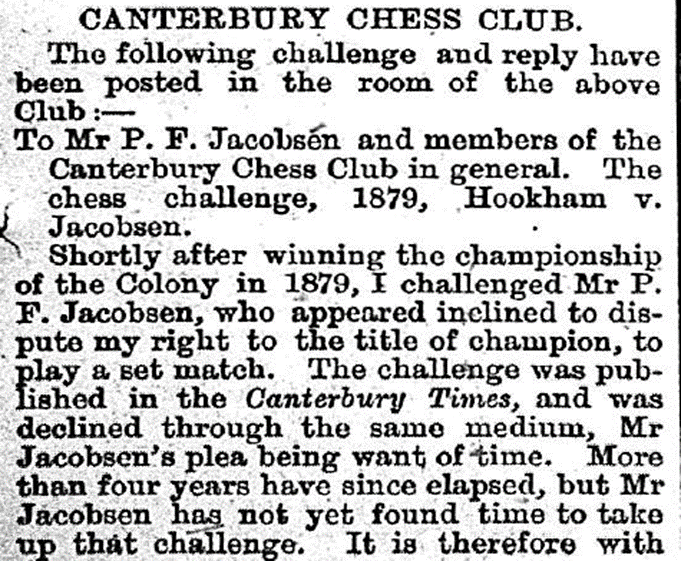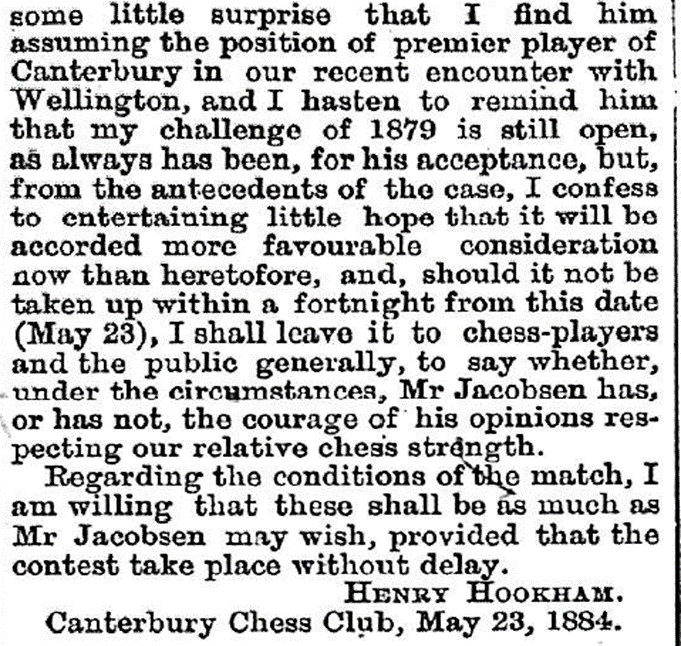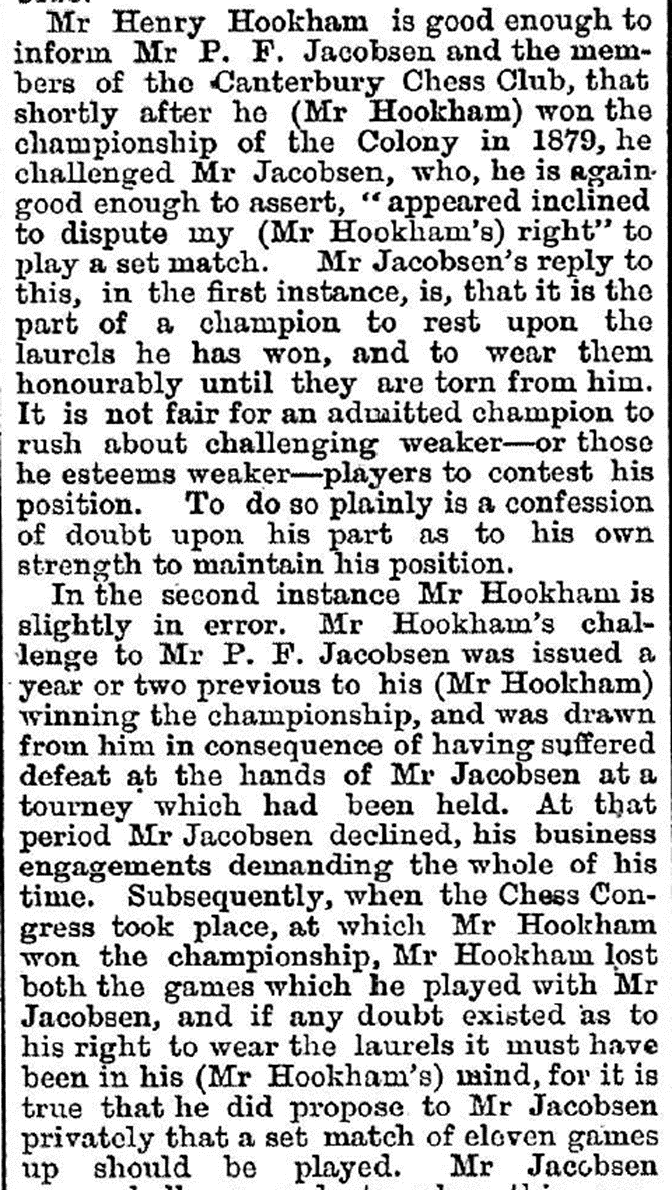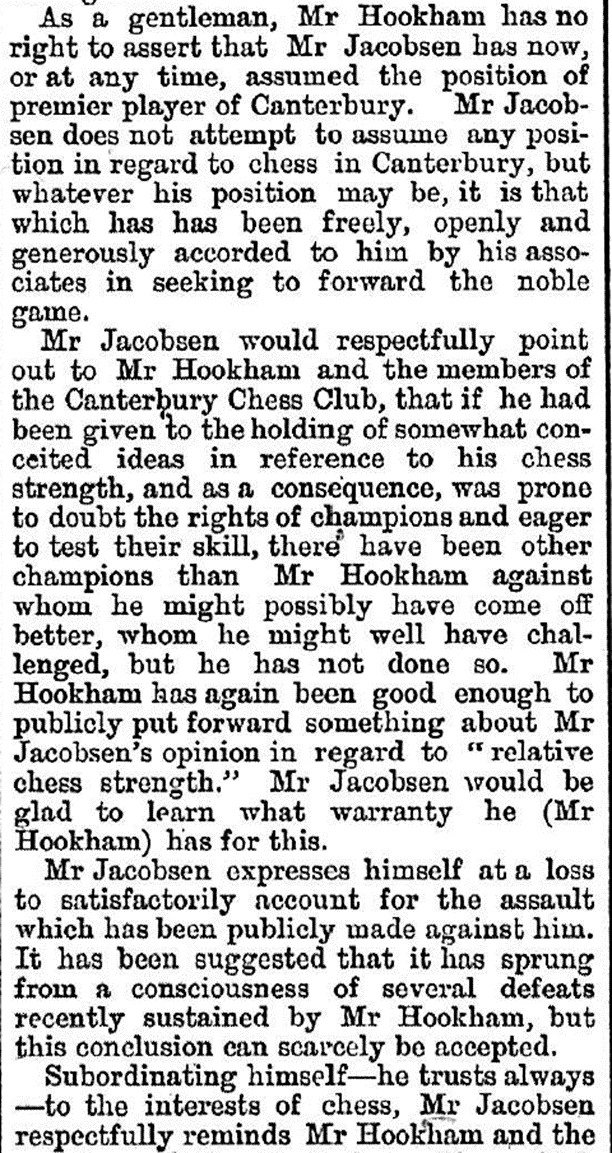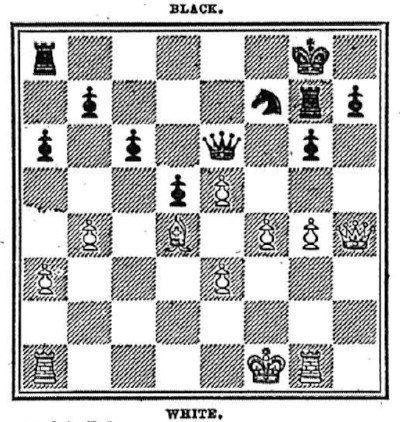H. Hookham vs. P. F. Jacobsen (1884)
An argument broke out between Hookham (NZ Champion) and Jacobsen as follows: [1]
The Evening Post of 11 June 1884 reported that Jacobsen had won the Canterbury CC Handicap Tourney as follows:
- 1st Jacobsen 33 pts
- 2nd Smith 29 pts.
- 3rd Hookham 28 pts.
Lyttelton Times, Volume LXI, Issue 7270, 18 June 1884
The match will start on Tuesday, July 1st.
Hookham stressed the match was NOT for the NZ Championship, as follows: [2]
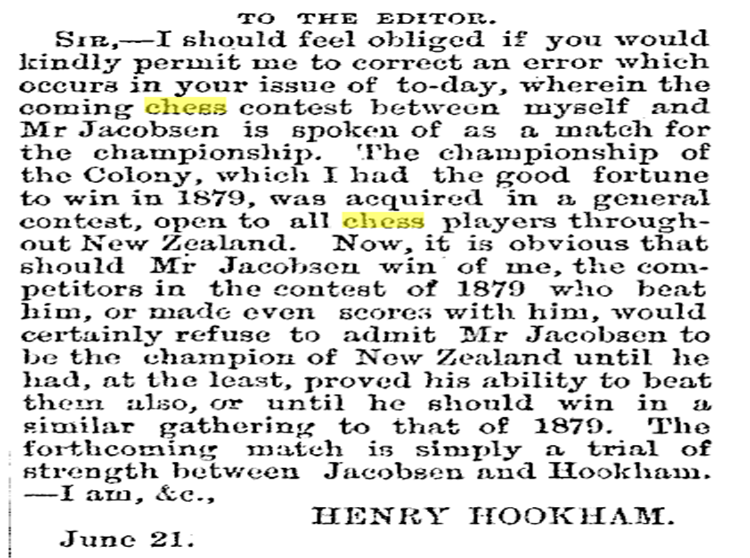
A correspondant also pointed this out: [2]

Another comment on this: [3]
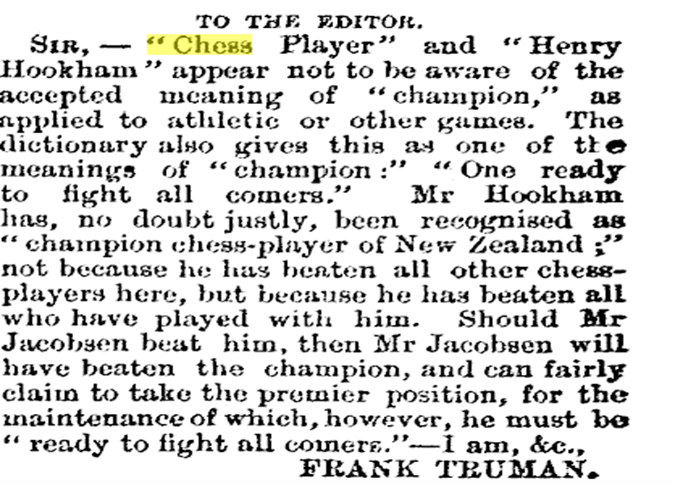
Lyttelton Times 2 July 1884
The match between Hookham and Jacobsen was begun yesterday afternoon. The terms are that the gentleman scoring the first seven wins is to be declared the winner of the match. Mr Hookham led with the English opening, and after about 6 hours play tho game was still undecided, though Mr Jacobson had won the exchange.
Play will be resumed on Friday next.
Hookham, H vs. Jacobsen, P. F, 1st Game, Match, Christchurch, 1884
Date "1884.07.01 & 04"
ECO "E12" Queen's Indian Defence
Annotators "HH - Hookham, H., Canterbury Times, 12 July, 1884" and
"CWB - Benbow, C. W., New Zealand Mail, 18 July 1884" and
"DRH - Hay, D. R., Otago Witness, 30 August 1884"
1. c4 {CWB - A good and sound method of beginning the game, and one calculated to bring about positions in which each combatant is soon thrown on his own resources. It is first mentioned in Carrera’s rare treatise of 1617 ; and our readers may remember that it was adopted by the London Chess Club in its celebrated match by correspondence with the Vienna Chess Club in 1872-1874. DRH - Not a bad way of commencing a match gamp, as it soon makes the players rely on their own resources.} 1... e6 {CWB - Black has a variety of replies at his command, though just now the text move is the most fashionable one.} 2. e3 Nf6 3. a3 {CWB - There seems to be no pressing necessity for this at the moment, as Black gains nothing by pinning the N. DRH - Losing valuable time.} 3... b6 4. Nc3 Bb7 5. Nf3 Be7 {CWB - Herr Zukertort says : “ Whenever the Queen’s fianchetto is adopted before playing the QP two squares, the opponents’ (Black’s) KB ought to be posted at e7 ; if on the other hand both players have advanced the Q P, the Bishop may be then played at once to d6."} 6. d4 d6 7. Be2 Nbd7 8. O-O c5 9. d5 exd5 10. cxd5 O-O 11. e4 Ne8 12. Qc2 Nc7 13. Rd1 {CWB - We do not quite see the meaning of this, although Mr Hookham doubtless had some good reason or other for its adoption. We should have preferred Bf4, preventing Black’s move of Bf6. DRH - We fail to see the ohject of this move, and to our mind it does not advance White's game one whit.} 13... Bf6 14. Bf4 Be5 {DRH - The best reply.} 15. Bg3 {DRH - White should have exchanged Bishops, and his two centre Pawns would then have become formldable.} Re8 16. Nxe5 {DRH - Too late now.} 16... Nxe5 17. f4 Ng6 18. Bg4 Bc8 19. Bxc8 Qxc8 20. h3 f6 21. f5 {CWB - The advance of this P strikes us as. premature and to have the effect of considerably weakening the group of centre Ps, as the e pawn is left a target to be aimed at.} Ne5 22. Rf1 {DRH - Proving the folly of his previous move.} 22... Re7 23. Qe2 Qe8 24. Rf2 Rd8 25. Raf1 {DRH - This looks like attacking his own forces. White should have supported his Q's P.} 25... b5 26. b3 a6 27. h4 a5 28. Nd1 {HH - White's game was a very promising one up to this point, and 28. Bxe5 would have rendered everything perfectly safe and have preserved his advantage. But the time limit was so nearly reached that this and the 2 following moves were simply rushed and with ruinous results, as will be speedily seen. CWB - White, from some cause or other, fails to grasp the situation, and serious trouble consequently results, Qd1 was the only move to avoid loss.} 28... Nf7 {CWB - A capital retort which wins a valuable P against any play.} 29. Rf4 {DRH - A serious oversight, which he pays dearly for.} 29... Nxd5 {DRH - Black takes good care not to allow such a fine chance of winning to escape.} 30. Rg4 {CWB - “With ruin upon ruin, rout on rout, Confusion worse confounded.” Winning for Black is now only a question of time.} Nh6 31. Nf2 Nc3 32. Qd3 Nxg4 33. Qxc3 Nxf2 34. Bxf2 Rxe4 {CWB - We presume that Black intentionally gave up his a pawn, as of course it was easily saved by b4.} 35. Qxa5 Ra8 36. Qd2 Qc6 37. b4 c4 38. Qc1 Rae8 39. Qc3 d5 40. g3 Qd7 41. Bd4 {CWB - White struggles bravely, but he is hopelessly in the toils.} Re2 42. Rf3 Re1+ 43. Kg2 R8e2+ 44. Kh3 {CWB - We should have played Rf2 on the chance - a remote one we however admit - that Black might take Qxf5 when Qxe1 would win.} Rh1+ 45. Kg4 Re4+ 46. Rf4 Rxf4+ 47. Kxf4 Rf1+ 48. Kg4 Qxf5# {DRH - Black finishes the game in good style.} 0-1
Jacobsen, P. F. vs. Hookham, H., 2nd Game, Match, Christchurch, 1884
Date "1884.07.04 & 08"
ECO "C01" French Defence, Exchange Variation
Annotator "HH - Hookham, H., Canterbury Times, 10 July, 1884" and
"CWB - Benbow, C. W., New Zealand Mail, 25 July 1884"
1. e4 e6 2. d4 {CWB - In the London International Tournament of 1883 Steinitz on some occasions continued here with e5; the move, however, seems to possess no special merit and was probably played for the sake of variety.} d5 3. exd5 exd5 4. Bd3 Bd6 5. Nf3 Nc6 {HH - Not good in the French Defence before the c pawn has been played to c5. CWB - 5... Nf6 is stronger than the text move.} 6. Be3 Be6 7. c3 Nce7 8. Qc2 Nf6 9. h3 c6 10. Nbd2 h6 {HH - This weakens his position materially and prevents castling on the K's side. 10... Ng6 seems preferable. CWB - This is unnecessary, at any rate for the present, as White would gain nothing by pinning the N, and is therefore weak and a waste of time.} 11. O-O Qc7 12. Rae1 Nd7 13. Nh4 O-O-O 14. f4 {CWB - An attacking move, which compels Black to an answer weakening his position.} 14... g6 15. f5 gxf5 16. Nxf5 Nxf5 17. Bxf5 {HH - White has played well, and has now a good attack, which increases as the game proceeds.} 17... Rdf8 18. Rf3 Qd8 19. b4 {CWB - Having broken up his opponents K’s-side, White now proceeds to make a diversion on the other flank.} 19... b6 20. Ref1 Bxf5 {CWB - We do not like this move, as it brings about a position which is difficult and unsatisfactory for Black.} 21. Qxf5 f6 22. b5 {CWB - Enterprising and good.} 22... cxb5 {HH - This loses position and a pawn. 22... Qc7 is better. CWB - This, however, cannot be commended as it involves the loss of a P. It nevertheless is difficult to suggest anything better, but possibly Qc7 would have been more to the purpose.} 23. Qxd5 Qc7 24. Ne4 Be7 25. Qxb5 Kb7 26. a4 a6 27. Qb3 a5 28. Bf4 Qc6 29. d5 Bc5+ 30. Kh1 Qc8 31. Bd6 {CWB - The attack is kept up with much spirit; and another P is now gained.} 31... Rf7 32. Bxc5 Nxc5 33. Nxc5+ Qxc5 34. Rxf6 Rxf6 35. Rxf6 Rf8 36. Rxf8 Qxf8 37. Qc4 Qd6 38. Qe4 Ka7 39. Qe6 Qf4 40. Qe7+ Ka6 41. Qe2+ {HH - 41. d6 at once is better. CWB - d6 would have been a more expeditious way of bring matters to a termination.} 41... Ka7 42. c4 Qd6 43. Qe6 Qf4 44. Qe7+ Ka6 45. d6 Qf1+ 46. Kh2 Qf4+ 47. Kg1 Qc1+ 48. Kf2 Qf4+ 49. Ke2 Qxc4+ 50. Kf3 Qb3+ 51. Kg4 Qg8+ {HH - Here Black's best line of play is 51... Qxa4+ when the game would proceed as follows 52. Kh5 Qb5+ 53. Kxh6 Qc5 and he would gain time to push on his a pawn 2 squares, and perhaps to promote it as quickly as his opponent's could be promoted.} 52. Kh5 {CWB - We prefer Kh4 followed by d7 if Qxg2; and by g4 if Qc4+.} 52... Qxg2 53. Kxh6 {HH - Here White might accelerate matters by d7.} 53... Qxh3+ 54. Kg7 Qg4+ 55. Kf8 Qf5+ 56. Qf7 Qc5 57. Qd7 Qf2+ 58. Ke8 Qf6 59. Qc6 Qh8+ 60. Kd7 Qb8 61. Qc8+ Qb7+ 62. Qxb7+ Kxb7 63. Ke8 b5 64. axb5 a4 65. d7 {Resigns.} 1-0
Jacobsen, P. F. vs. Hookham, H., 4th Game, Match, Christchurch, 1884
Date "1884.07.25"
ECO "C01" French Defence, Exchange Variation
Annotator "HH - Hookham, H., Canterbury Times, 2 August, 1884" and
"DRH - Hay, D. R., Otago Witness, 6 September 1884"
1. e4 e6 2. d4 d5 3. exd5 exd5 4. Bd3 Bd6 5. Nf3 Nf6 6. O-O O-O 7. c3 c6 8. Bg5 Bg4 9. Nbd2 Nbd7 10. Qc2 Qc7 {DRH - It is pretty even so far.} 11. Rae1 Rfe8 12. Bh4 g6 13. h3 Be6 14. Ng5 Kg7 15. Nxe6+ Rxe6 16. Rxe6 fxe6 {HH - The exchanges forced by White have not improved his prospects.} 17. Re1 Re8 18. Nf3 e5 19. dxe5 Nxe5 20. Bxf6+ Kxf6 21. Nxe5 Bxe5 {DRH - These and the previous exchanges were very ill advised on White's part. Black has now much the better game.} 22. Kh1 Re7 23. Qa4 b6 24. Qh4+ Kg7 25. Qg4 c5 26. Qe2 Bf6 27. Qd1 {DRH - These moves of the Queen have lost valuable time.} 27... d4 28. Rxe7+ Qxe7 29. cxd4 {HH - 29. c4 is better.} 29... Bxd4 30. Qd2 Qf6 31. f3 Bxb2 {DRH - Black should have an easy win now } 32. Qe2 Be5 33. Kg1 Bg3 34. Bb1 {HH - White's best continuation appears to be 34. Bc4 but in any case with proper care Black should Win.} 34... b5 {HH - The obvious 34... Qd4+ followed by the advance of the pawn's on the Queen's side is the direct road to victory. Still the text move is good enough with correct after play. DRH - Very weak ; Qd4+, and then nothing could have stopped Black queening one of his Pawns.} 35. Qd2 {HH - If 35. Qxb5, of course 35... Qd4+ and mates next move.} 35... Qa1 {DRH - Very poor, as it allows Black's winning advantage to slip through his fingers.} 36. Qd7+ Kh6 37. Qd2+ g5 {HH - Here 37... Kh5 should have been played, then if 38. Qd5+ Qe5 and whether White exchanged Queens or moved Q, Black would still retain a winning position. DRH - From bad to worse. Kh5 should have been played, but Black's play throughout the latter part of the game shows that he could not have been in his usual form.} 38. Qd3 Qd4+ {HH - A palpable blunder, Black had nothing whatever now to gainby exchanging Queens.} 39. Qxd4 cxd4 {HH - The game was prolonged to the 52nd move, and was then drawn by mutual consent.} 1/2-1/2
Hookham, H vs. Jacobsen, P. F, 5th Game, Match, Christchurch, 1884
Date "1884.08.??"
ECO "A13" English Opening
Annotators "CWB - Benbow, C. W., New Zealand Mail, 15 August 1884" and
"DRH - Hay, D. R., Otago Witness, 6 September 1884"
1. c4 e6 2. e3 f5 {CWB - In a previous game at this opening Black played Nf6 here, which move is possibly a shade stronger than the present one; the latter, however, introduces desirable variety into the contest. DRH - Bold, but worthy of commendation, as it secures a comparatively free and open game.} 3. g3 Nf6 4. Bg2 Be7 {CWB - 4... c6 followed by 5... d5 and 6... Bd6 strikes us as being better.} 5. d4 c6 6. Nf3 O-O 7. O-O d5 8. b3 b6 9. Nc3 Bb4 {CWB - What was the objection to 9...dxc4 10. bxc4 c5, and whatever White does Black comes out better than in the actual game. DRH - Very ill advised as it only confirms White's previous intention of bringing this N round to his Kjng's quarters, and after this is done the B is helpless, and commands nothing.} 10. Ne2 Ba6 11. a3 {DRH - A gentle hint.} 11... Be7 12. Nf4 Bc8 {CWB - Valuable time has been wasted during the last few moves, the result being that at this juncture White has the better position. DRH - Proving that his previous venture was of no real service.} 13. Ng5 {CWB - The attack is maintained in good style ; this insures the gain of a Pawn. DRH - Well played.} 13... Re8 14. Ngxe6 Bxe6 15. Nxe6 Qd7 16. Nf4 g5 17. Nd3 dxc4 18. bxc4 Qe6 19. Qc2 Nbd7 20. Nb4 Rac8 21. Bb2 Ne4 22. d5 {CWB - This is too impetuous and against the best defence promises no advantage, in fact rather to the contrary. Our idea would have been 22. f3 Nef6 23. e4 fxe4 24. fxe4 etc., and White has a fine centre of pawns. DRH - Too eager to win ; White should have played f3, followed by e4 with a fine game.} 22... cxd5 23. Nxd5 Qxd5 {DRH - Capitally played.} 24. Rad1 Qe6 25. Bxe4 fxe4 26. Rxd7 {DRH - A highly creditable stroke, which his opponent did not see the full force of until it was too late.} 26... Qxd7 27. Qc3 {CWB - White plays ingeniously and well, but a draw was all he could reasonably expect to make.} 27... Qf5 {CWB - A deplorable and unaccountable oversight in a match game, he could easily have drawn by 27... Kf7; 28... Bf6; etc. DRH - One of those unaccountable mistakes which occasionally occur with the best of players even in important match games.} 28. Qg7# {DRH - White deserves praise for the admirable way he has conducted the latter part of the game.} 1-0
Jacobsen, P. F. vs. Hookham, H., 6th Game, Match, Christchurch, 1884
Date "1884.08.01 & 05"
ECO "A03" Bird's Opening
Annotators "CWB - Benbow, C. W., New Zealand Mail, 22 August 1884" and
"HH - Hookham, H., Canterbury Times, 16 August, 1884"
1. f4 {CWB - A favorite opening with the well-known English amateur H. E. Bird ; Steinitz, Zukertort, Blackburne, and Mason do not, however, approve of this form of commencement.} 1... e6 {CWB - An interesting continuation is 1... e5 2. fxe5 d6 3. exd6 Bxd6 4. Nf3 Bg4, though the sacrifice would perhaps be hardly prudent in a match game.} 2. Nf3 d5 3. e3 Nf6 4. b3 Be7 5. Bb2 a6 6. d3 b5 7. Be2 c5 8. O-O O-O 9. Ne5 Nfd7 10. Nd2 f6 {CWB - Extreme caution on both sides has so far marked the way.} 11. Nxd7 Nxd7 12. c4 Nb6 13. Rc1 Bb7 14. Bf3 Qd7 15. Re1 Rac8 {CWB - The game of each player is now fairly developedand some interesting manoeuvering may be looked for.} 16. Qe2 b4 17. d4 f5 18. dxc5 Bxc5 19. Bd4 Bxd4 {CWB - This is rather playing the adversary's game, and cannot, therefore, be commended; Qe7 would have been better chess. HH - The capture is extremely ill-judged. It at once provides the antagonist with a valuable passed Pawn, and a strong attack, 19... Qe7 would have met the exigencies of the case. If then 20. cxd5 exd5.} 20. exd4 Rfe8 21. c5 Na8 22. Qe5 Rcd8 23. Rc2 Nc7 {HH - A slip which should cost a piece, and, something more.} 24. Be2 {CWB - White fails to take advantage of his opponents last hasty move. He should have advanced 24. c6 and victory would have been in his grasp. HH - 24. c6 Bxc6 25. Rec1 and Black must lose B or N at the least.} 24... Bc6 {CWB - Black sees his danger and provides for it.} 25. Nf3 g6 26. Bd3 Qe7 27. Ng5 h6 {CWB - He dare not let the N remain where it now stands, otherwise he loses his KP by Rce2.} 28. Nf3 Bb5 29. Bxb5 Nxb5 30. Qe3 Rc8 31. Qd2 {CWB - White is casting longing glances on the weak b pawn.} 31... Nc3 32. a3 a5 33. axb4 axb4 34. Rcc1 Kg7 35. Ne5 Qc7 {HH - The b pawn cannot be saved.} 36. Nd3 {CWB - And his longing is now satisfied.} 36... Ne4 37. Qxb4 Rb8 38. Qa3 Nd2 39. b4 Nc4 40. Qc3 g5 41. fxg5 hxg5 42. Ne5 Nxe5 43. Rxe5 Kf6 44. Rb1 {CWB - Preparing the way for the advance of his passed P's.} 44... Qc6 45. Re2 Qc7 46. b5 Rh8 47. Qg3 Qxg3 48. hxg3 Rhc8 49. b6 {CWB - The game is now practically over, the termination moves, however, are very instructive.} 49... Ke7 50. Rbe1 Rc6 51. Ra2 Rb7 52. Rea1 Kd7 53. Ra8 Rc8 54. Rxc8 Kxc8 55. Ra8+ Kd7 56. Ra7 Kc6 57. Rxb7 Kxb7 58. Kf2 Kc6 59. Ke3 Kb7 60. Kd3 Kc6 61. Kc3 Kb7 62. Kb4 Ka6 63. Ka4 {and Black resigns.} 1-0
Hookham, H vs. Jacobsen, P. F, 7th Game, Match, Christchurch, 1884
Date "1884.08.08"
ECO "A13" English opening
Annotators "CWB - Benbow, C. W., New Zealand Mail, 29 August 1884" and
"HH - Hookham, H., Canterbury Times, 16 August, 1884"
Jacobsen, P. F. vs. Hookham, H., 8th Game, Match, Christchurch, 1884
Date "1884.08.12"
ECO "A03" Bird's Opening
Annotators "CWB - Benbow, C. W., New Zealand Mail, 19 September 1884" and
"HH - Hookham, H., Canterbury Times, 28 August, 1884"
1. f4 e6 2. Nf3 d5 3. e3 Nf6 4. b3 Be7 5. Bb2 O-O 6. Ng5 h6 7. h4 Nc6 {CWB - This and the preceding move are interesting, but they do not advance the game much. If Black capture the Knight 7...hxg5, then follows 8. hxg5 g6 9. gxf6 etc.} 8. Nf3 Ne4 9. g4 Ng3 10. Rh3 Nxf1 {CWB - We are inclined to think that Black would have done better if he had developed his game ratliercthan have made so much use of this ivt, the result of which has in no way prejudiced White.} 11. Kxf1 Bf6 12. d4 Be7 {CWB - Necessary, as otherwise, White would have forced a in the entrenchments of the Black K by g5, etc.} 13. Rh2 {CWB - This also was a precautionary move against 13... e5.} 13... f5 14. g5 h5 {HH - 14... Kh7 looks a trifle better.} 15. g6 {CWB - White’s position on this side is now becoming formidable. In addition to this Black’s game is much cramped, and as a result he is very helpless.} 15... Rf6 16. Rg2 Qe8 17. Ng5 {CWB - 17. Ne5 would have been much more effective, and would it seems to us, have given him a practically won game. Supposing 17... Nxe5, then the following is probable 18. dxe5 Rxg6 19. Qxh5 Qb5+ 20. c4 and wins.} 17... Rxg6 18. Qxh5 Bxg5 19. hxg5 Kf7 {CWB - The K R is now in a very critical position, and the text move does not tend to improve matters. Had Black, however, played 19... e5 he would not have benefited himself much, e.g. 20. dxe5 Re6 21. g6 and Black’s game is an exceedingly unpleasant one.} 20. Nd2 Bd7 21. Rh2 e5 22. Nf3 e4 {HH - 22... exf4 opens the e file to the hostile QR.} 23. Nh4 Ne7 24. Ba3 Qh8 25. Qxh8 Rxh8 26. Bxe7 Rxh4 27. Rxh4 Kxe7 28. Ke2 {CWB - From this point Black plays an hopeless game ; the terminating moves are nevertheless very interesting, skilfully played, and are worthy of careful study.} 28... Be6 29. Rh8 a5 30. Rb8 b6 31. Rh8 Kd7 32. Rah1 Bf7 33. Kd2 Rc6 34. R8h7 Rg6 35. Kc3 Ke7 36. Kb2 Kd7 37. a3 Ke7 38. c3 Kd7 39. b4 axb4 40. axb4 Ke7 41. Rh8 Rd6 42. b5 g6 43. R1h7 Rd7 44. Rg7 Ke6 45. Rf8 Re7 46. Kb3 Be8 47. Rf6+ Kd7 48. Rxe7+ Kxe7 49. Kb4 Bf7 50. c4 dxc4 51. d5 Bxd5 52. Rxg6 Be6 53. Rxe6+ Kxe6 54. Kxc4 c5 55. bxc6 Kd6 56. g6 {Resigns.} 1-0
{HH - Jacobsen plays well throughout, particularly the latter part of the game.}
Hookham, H vs. Jacobsen, P. F, 9th Game, Match, Christchurch, 1884
Date "1884.08.15 & 19"
ECO "E14" Queen's Indian Defence
Annotators "CWB - Benbow, C. W., New Zealand Mail, 26 September 1884" and
"HH - Hookham, H., Canterbury Times, 30 August, 1884"
1. c4 e6 2. Nc3 Nf6 {CWB - There is no advantage to be gained by 2... Bb4.} 3. e3 {CWB - 3. d4 is a trifle better.} 3... b6 4. Nf3 Bb7 5. Be2 Be7 6. O-O O-O 7. d4 d6 8. Qc2 Ne8 9. Ne1 f5 10. f3 Bf6 {CWB - A move of very doubtful utility, and Black soon recognises its weakness as he goes back with the piece next move to the square from whence it came,} 11. Bd3 Be7 12. d5 Qd7 13. e4 f4 {CWB - his advanced P soon becomes a target for attack and eventually falls.} 14. dxe6 Qxe6 15. Nd5 Bg5 16. g3 Bxd5 17. cxd5 Qh6 {CWB - 17... Qh3 would have been no better as White would have continued with Qg2, retaking with N if Qxg2, and proceeding as in the actual game if the Q retreats.} 18. h4 Bf6 19. Bxf4 Bd4+ 20. Kg2 Qh5 21. Kh3 Nd7 22. g4 Qf7 23. Bg3 Nc5 24. Rb1 a5 25. Kg2 h5 26. g5 Qd7 27. Be2 g6 28. Nd3 Ng7 29. Nf4 Qf7 30. Nd3 Rae8 31. a3 Qe7 32. Nf4 Kh7 33. Rbe1 {CWB - We should have preferred to have pursued the attack as follows : 33. e5 Qxe5 34. Qxg6+ Kg8 35. b4 axb4 36. axb4 Nd7 37. Bd3 etc.} 33... Be5 34. Nd3 Nxd3 35. Bxd3 Bxg3 36. Kxg3 Qd7 37. Be2 Rf7 38. Bd3 Ref8 39. f4 Re8 40. Qd2 Rfe7 41. Bc2 Kg8 42. Kh2 Rf8 43. Bd1 Rfe8 44. Bf3 Rf8 45. Kg3 Ref7 46. Bd1 Re7 47. Kh2 {CWB - Both players seem to be “netting I dare not, wait upon I would,” and as a result their conduct of the game hereabouts is marked by irresolution and vacillation.} 47... Rfe8 48. Bf3 Rf8 49. Rc1 Rfe8 50. Rg1 {CWB - We now get a new departure, which so far is satisfactory.} 50... Rf8 51. Rcf1 Ref7 52. Bd1 Re7 53. Bc2 Kf7 {CWB - A slip which should have cost the game.} 54. e5 Ke8 55. Bxg6+ Kd8 56. e6 Nxe6 57. dxe6 Qxe6 58. f5 {CWB - This is calculated to lead White into difficulty and danger, Bd3 or Bxh5 would have been stronger.} 58... Qc4 {CWB - An excellent retort, which evidently had escaped White’s notice.} 59. Qf4 {CWB - Surely this is not making the most of the position ; Rf2 is infinitely better. HH - From bad to worse! 59. Rf2 Qxh4+ 60. Kg2 Qg4+ (best) 61. Kh1 Qh4+ or h3+ 62. Rh2 Qf3+ or e4+ 63. Qg2 and White still comes off with a won game.} 59... Re4 60. Qc1 {CWB - This completes what the two preceding moves have assisted towards, and White is now helpless. It is pitiful to see a game thrown away in the manner this one has been. HH - From worse to worse! Black has now a forced win, whereas after 60. Qf3 he can only force a draw. To that move he would reply 60... Rxh4+ 61. Kg3 Rg4+ 62. Kh3, etc.} 60... Rxh4+ 61. Kg3 Qg4+ 62. Kf2 Rh2+ 63. Ke3 Re2+ 64. Kd3 Qe4+ 65. Kc3 b5 66. Qf4 {CWB - 66. Rf4 would have prolonged the game somewhat; White, however, probably preferred a speedy exit to a lingering existence.} 66... Qc2+ 67. Kd4 Qc4# 0-1
Jacobsen, P. F. vs. Hookham, H., 10th Game, Match, Christchurch, 1884
Date "1884.08.22"
ECO "A03" Bird's Opening
Annotator: "HH - Hookham, H., Canterbury Times, 30 August, 1884"
1. f4 e6 2. Nf3 Nf6 3. e3 d5 4. b3 Be7 5. Bb2 O-O 6. d3 c5 7. Be2 Nc6 8. O-O Ng4 {HH - Premature, because 9... d5 would be unsound.} 9. Qd2 Bf6 10. d4 Nh6 11. c3 Be7 12. Bd3 f5 13. Bb5 {HH - Well Played.} 13... a6 {HH - And badly met. The exchange of pieces saddles Black with a weak QB Pawn. 13... Qb6 is the correct play.} 14. Bxc6 bxc6 15. Ba3 cxd4 16. Bxe7 Qxe7 17. cxd4 Ng4 18. h3 Nf6 19. Qc2 Bb7 {HH - Bolder and sounder were 19... Ne4. If then 20. Qxc6 Bd7 and Black would acquire an attack of considerably greater value than the pawn sacrifice.} 20. Nbd2 {HH - 20. Nc3 is preferable, we think, with a view to promoting him shortly to b6 or c5.} 20... Rfc8 21. Rac1 Rc7 22. Ne5 Rac8 23. Qc5 Qxc5 24. Rxc5 Nd7 25. Nxd7 Rxd7 26. Nf3 Re7 27. Rfc1 Kf8 28. b4 Ree8 29. Ne5 Ke7 30. Nxc6+ Bxc6 31. Rxc6 Rxc6 32. Rxc6 Ra8 33. a4 {HH - 33. Rc7+ would enable White to win by confining the Black K to his own side of the board.} 33... Ra7 34. b5 Kd7 35. Rc5 axb5 36. axb5 Ra1+ 37. Kf2 Rb1 38. Kf3 h5 39. g4 hxg4+ 40. hxg4 g6 41. gxf5 gxf5 42. Ke2 Kd6 {HH - Unnecessary, the position as it stands being a draw.} 43. Rc6+ Kd7 44. Rb6 Rb4 45. Kf3 Rb3 46. Rb7+ Kd6 47. b6 Rb1 48. Kg3 Rb3 49. Kh4 Kc6 {HH - If 49... Rxe3 50. Rf7 Rb3 51. b7 Kc6 52. Kg5 Rb4 (52... Rxb7 53. Rxb7 Kxb7 54. Kf6 winning.) 53. Kf6 Kd6 54. Re7 Rb1 55. Rxe6+ Kc7 56. Re7+ Kc6 57. Kxf5 and wins.} 50. Rb8 Rxb6 51. Rxb6+ Kxb6 52. Kg5 Kc6 53. Kf6 Kd6 54. Kf7 Kd7 55. Kf8 Kd8 56. Kg8 Ke8 57. Kh7 Kf7 {Drawn.} 1/2-1/2
Hookham, H vs. Jacobsen, P. F, 11th Game, Match, Christchurch, 1884
Date "1884.08.26"
ECO "D30" Queen's Gambit Declined
Annotator: "HH - Hookham, H., Canterbury Times, 6 September, 1884"
1. Nf3 d5 2. d4 e6 3. e3 Nf6 4. Be2 c5 5. c4 b6 6. O-O Bb7 {HH - 6... Be7 is better.} 7. Ne5 Be7 8. Qa4+ Nbd7 9. cxd5 Bxd5 10. Nc3 a6 11. Nxd5 b5 {HH - An error 11... exd5 is less unsatisfactory, White could not then safely play 12. Bxa6.} 12. Nxf6+ gxf6 13. Nxf7 Kxf7 14. Bh5+ Kg7 15. Qd1 f5 16. e4 Nf6 17. exf5 exf5 18. dxc5 Qxd1 19. Bxd1 Bxc5 20. Bf3 {HH - 20. Be3 is preferable.} 20... Ra7 21. Bf4 Bd4 22. Rab1 Rc8 23. Rfc1 Rxc1+ 24. Bxc1 Rc7 25. Be3 Bxe3 26. fxe3 Rc2 27. Kf1 Ne4 28. Ke1 {HH - 28. Bxe4 would be a serious blunder. The B is of more value than the N in the present position, as will soon be seen.} 28... Nc5 29. Be2 Na4 30. Kd1 Rxb2 {HH - To retreat the R is better generalship than this capture. After the exchange of Rooks, the weakness of White's game becomes apparent.} 31. Rxb2 Nxb2+ 32. Kc2 Na4 33. Kb3 Kf6 34. Kb4 Ke5 35. Bf3 Kd6 36. Bb7 a5+ 37. Kxa5 Kc5 38. Bc8 Nb2 39. Bxf5 Nc4+ 40. Ka6 Nxe3 41. g4 b4 42. Bxh7 Nxg4 43. h4 Nf6 44. Bc2 Kc4 45. Bb3+ Kc3 46. Kb5 Ng4 47. Ka5 Nf6 48. Bf7 Ng4 49. h5 Nh6 50. Bb3 {HH - 50. Be6 at once would save time.} 50... Nf5 51. Be6 Nh4 52. Kb5 Kd4 53. Kxb4 Ke5 54. Bb3 Kf6 55. a4 Nf5 56. a5 Ne7 57. Kb5 Nc8 58. a6 Kg5 59. Bd1 Nd6+ 60. Kc6 Nc8 61. Kc7 Na7 62. Be2 {HH - Could Black have succeeded in sacrificing his N for the a pawn, the game must have been drawn, for the White B not commanding h8, the h pawn could never advance to that square, as the Black K would occupy it and could not be driven away.} {Resigns.} 1-0
Jacobsen, P. F. vs. Hookham, H., 12th Game, Match, Christchurch, 1884
Date "1884.08.29"
ECO "C01" French Defence, Exchange Variation
Annotator: "HH - Hookham, H., Canterbury Times, 13 September, 1884"
1. e4 e6 2. d4 d5 3. exd5 exd5 4. Nf3 Bd6 5. Bd3 Nf6 6. O-O O-O 7. c3 Bg4 8. Bg5 Nbd7 9. Nbd2 Bh5 10. Bf5 Be7 11. Re1 h6 12. Bh4 Re8 13. Qc2 g6 14. Bd3 Kg7 15. h3 g5 16. Bg3 Nf8 17. Be5 {HH - 17. Ne5 is more effective, to be followed soon after by f4.} 17... Bg6 18. Bxg6 {HH - Which brings the opponent's N at once to a more influential position. A move is gained by leaving to Black the initiative in taking.} 18... Nxg6 19. Bxf6+ Bxf6 20. Rxe8 Qxe8 21. Qb3 Qc6 22. Re1 b6 23. Nf1 {HH - This N is evidently en route for f5 or h5.} 23... Qd7 24. Ng3 Kh7 {HH - White threatened to win the B by checking at h5.} 25. Nh5 Bh8 26. Nh2 {HH - Perhaps 26. Qc2 and 27. Qe2 is a stronger line of play. The object of the text move, the bringing the 2 N's to bear on f6, is effectually frustrated by Black's reply.} 26... f5 27. Qc2 Qf7 28. Ng3 Rf8 {HH - The R comes into play at last.} 29. Ngf1 f4 30. Nd2 Re8 31. Rxe8 Qxe8 32. Ndf3 Kg8 33. Ng4 Bg7 34. Qf5 Qf7 35. Qc8+ Kh7 36. Qa6 {HH - White might now win a Pawn by 36. b4. If 36... Qe7 then 37. Qb7. If 36... a5 then 37. bxa5 bxa5 38. Qa6, etc.} 36... c5 37. Qe2 cxd4 38. cxd4 Kg8 39. Nfe5 Qe7 40. Qb5 Nxe5 41. Nxe5 Qe6 42. Nf3 {Drawn.} 1/2-1/2
Hookham, H vs. Jacobsen, P. F, 13th Game, Match, Christchurch, 1884
Date "1884.09.02"
ECO "E14" Queen's Indian Defence
Annotators "DRH - Hay, D. R., Otago Witness, 27 September 1884"
1. c4 e6 2. e3 Nf6 3. Nf3 Be7 4. Be2 b6 5. O-O Bb7 6. d4 O-O 7. b3 d5 8. Bb2 Nbd7 9. Nc3 c5 10. Rc1 cxd4 11. exd4 Rc8 12. Re1 Ba6 {DRH - A Bad mistake Up to this point the game was very oven.} 13. cxd5 Bxe2 {DRH - Black must surely have been upset when he discovered his previous mistake, for with ordinary care he might easily have seen that Bb7 was much better than the move in the text.} 14. Qxe2 Re8 15. dxe6 fxe6 {DRH - Again. Black makes matters worse by capturing this P. Nf8 would have been preferable.} 16. Qxe6+ Kh8 17. Ng5 Qc7 18. Nf7+ Kg8 19. Nd6+ Kf8 {DRH - The game was vlrtualv over," but. Kh8 would have prolonged it a few moves. This game is a capital illustration of how fatal a single slip may prove when properly taken advantage of.} 20. Qf7# 1-0
Jacobsen, P. F. vs. Hookham, H., 14th Game, Match, Christchurch, 1884
Date "1884.09.05"
ECO "A03" Bird's Opening
Annotator: "HH - Hookham, H., Canterbury Times, 27 September, 1884"
1. f4 e6 2. Nf3 Nf6 3. e3 d5 4. b3 Be7 5. Bb2 O-O 6. Be2 c5 7. d3 b6 8. O-O Bb7 9. Ne5 Ne8 10. Nd2 Nc6 11. Nxc6 Bxc6 12. Nf3 Nd6 13. Ne5 Bb7 14. Bg4 f5 15. Bf3 Bf6 16. Rc1 Nf7 17. Nxf7 Rxf7 18. Bxf6 Qxf6 19. c4 Rd8 20. cxd5 Bxd5 21. Qc2 Bxf3 22. Rxf3 Rfd7 23. Rd1 h6 24. Rf2 Kh7 25. Qc4 Rd6 {HH - 25... g5 was a more promising continuation.} 26. g3 Qe7 27. Rc2 Qd7 28. Rcd2 Qc6 29. Kf2 Qe8 30. Qc3 {Drawn.} 1/2-1/2
Jacobsen, P. F. vs. Hookham, H., 16th Game, Match, Christchurch, 1884
Date "1884.09.12"
ECO "A03" Bird's Opening
Annotator: "HH - Hookham, H., Canterbury Times, 4 October, 1884"
1. f4 e6 2. Nf3 Nf6 3. e3 d5 4. b3 Be7 5. Bb2 O-O 6. Be2 c5 7. d3 b6 8. O-O Nc6 9. Ne5 Bb7 10. Nd2 Nd7 11. Nef3 Bd6 12. d4 Ne7 13. Bd3 Nf5 14. Bxf5 exf5 15. c3 Re8 16. Re1 Nf8 17. Qc2 g6 18. Nf1 Ne6 19. Rad1 Rc8 20. Qb1 f6 21. Ng3 cxd4 22. Nxd4 Nxd4 {HH - 22... Bc5 appears stronger.} 23. Rxd4 Bc5 24. Rd3 Qc7 25. b4 Be7 26. a4 Kg7 27. Ne2 a6 28. Nd4 Bd6 29. Rd2 Re4 {HH - A slip which costs the exchange. 29... Re7 and 30... Rce1 is the proper continuation.} 30. Qxe4 fxe4 31. Ne6+ Kf7 32. Nxc7 Rxc7 33. g3 Ke7 34. h4 h5 35. Kf2 f5 36. Ra1 Ke6 37. Rc1 Rc4 38. Rd4 Be7 39. Ke2 Bf6 {HH - 39... b5 to block out the adverse Bishop seems best.} 40. Rxc4 dxc4 41. b5 a5 42. Ba3 Bd5 43. Bf8 Bd8 44. Rd1 Bf6 45. Kd2 Bd8 46. Kc2 Bf6 47. Bh6 Be7 48. Bg5 Ba3 49. Bd8 Bc5 50. Bc7 {HH - A sad oversight, completely changing the fortunes of the fight.} 50... Bxe3 51. Be5 {HH - Better was 51. Re1. Black must reply 51... Bc5 and the game would probably eventuate in a draw.} 51... Bf2 52. Bd4 e3 53. Rf1 {HH - If 53. Bxe3 Bxe3 54. Re1 Be4+ 55. K moves Bf2 and Black should win. 53. Rc1 was very preferable to the text move.} 53... Be4+ 54. Kd1 Bf3+ 55. Kc2 e2 56. Rc1 e1=Q 57. Rxe1+ Bxe1 58. Bxb6 Bxg3 59. Bxa5 Bxf4 60. Bd8 Kd7 61. Bf6 Bc7 {HH - And after a few more moves White resigned.} 0-1
Hookham, H vs. Jacobsen, P. F, 17th Game, Match, Christchurch, 1884
Date "1884.09.23"
ECO "E14" Queen's Indian Defence
Annotator: "HH - Hookham, H., Canterbury Times, 11 October, 1884"
1. c4 e6 2. e3 Nf6 3. Nf3 Be7 4. Be2 b6 5. O-O Bb7 6. d4 O-O 7. b3 d6 8. Bb2 Nbd7 9. Nc3 Re8 10. Qc2 d5 11. Ne5 c6 12. f4 Rc8 13. Bf3 {HH - 13. Bd3 is better followed by Ne2.} 13... c5 14. Qe2 {HH - Nor is this satisfactory. 14. Rac1 is more suitable preperation for contingencies.} 14... cxd4 15. exd4 Ba6 16. Rfe1 {HH - With the idea of sacricing the N by taking the f pawn, but Black's next move frustrates the design.} 16... Bb4 17. Rec1 Nb8 18. Nb5 Bxb5 19. cxb5 Re7 20. Rxc8 Qxc8 21. a3 ? Bd6 {HH - To c3 is perfectly safe and more attacking, 21... Bc3 22. Rc1 Rc7 (If 22... Bxd4+ Kmoves and Black loses his Q or B.) 23. Bxc3 ! Rxc3 etc.} 22. Rc1 Rc7 23. Rxc7 Qxc7 24. g3 g6 25. Kg2 {HH - White should endevour to force an exchange of Queens, and afterwards bring N to c6 the vulnerable point in Black's game.} 25... Nfd7 26. Nd3 Nf6 27. Ne5 Nfd7 {HH - Repitition moves. Neither player had much time to spare.} 28. Ng4 Kg7 29. Nf2 Nf6 30. Qd3 Nbd7 31. h4 h5 32. Bd1 Bxf4 {HH - A bold but rather too speculative sacrifice.} 33. gxf4 Qxf4 34. Qg3 Qd2 35. Bc3 Qa2 36. Bb4 Ne4 37. Qe3 Ndf6 38. Qe2 Qa1 39. Nxe4 Nxe4 40. Qd3 Qc1 41. Kf3 {HH - 41. Bc2 is the correct continuation. If then 41... g5 42. Qe2 and the N must move or be captured. In either case the strength of Black's position is gone.} 41... Qc7 {HH - The strongest move at Black's command is now 41... g5 enabling him to draw by force; which the present move, properly met, does not.} 42. Be1 Qh2 43. Qf1 {HH - Badly played; but time was getting short, 43. Qe2 Qh3+ (best) 44. Kf4 f6 45. Qf3 g5+ 46. hxg5 fxg5+ 47. Ke3 and White should win.) 43... Qb2 44. Qd3 Qxa3 45. Bd2 {Time - 2hr 59min} 45... Nxd2+ 46. Qxd2 Qe7 {HH - White proposed a draw, which was accepted.} 1/2-1/2
Jacobsen, P. F. vs. Hookham, H., 20th Game, Match, Christchurch, 1884
Date "1884.10.14"
ECO "A30" English Opening, Symmetrical Variation
Annotators "CWB - Benbow, C. W., New Zealand Mail, 24 October 1884" and
"HH - Hookham, H., Canterbury Times, 30 August, 1884"
1. c4 c5 2. e3 {CWB - In a game in the celebrated match between Staunton and St. Amant the continuation was: 2. Nc3 Nc6 3. e3 d6 4. d4 etc. White also could proceed with either 2. e4 or 2. f4.} 2... Nc6 3. Nf3 e6 4. Be2 Nf6 5. O-O Be7 6. b3 O-O 7. Bb2 d5 8. d4 b6 9. Nc3 a6 {HH - 9... Bb7 should be played.} 10. Rc1 Bb7 11. dxc5 dxc4 {HH - 11... Bxc5. is better.} 12. Na4 {CWB - This is superior to 12. Bxc4 at once, as it breaks up the pawns on the Queens wing and makes the isolated one a point of attack.} 12... bxc5 13. Bxc4 Nd7 14. Be2 Qc7 {HH - Which loses a Pawn. 14... Rc8 is the proper continuation. If then 15. Ba3 Nb4.} 15. Ba3 Nce5 16. Nxe5 Nxe5 17. Nxc5 Rfd8 18. Nd3 {HH - 18. Qc2 is preferable.} 18... Nc6 19. Bxe7 {HH - It were better, we think, to retire the B to b2.} 19... Qxe7 20. Bf3 {CWB - A mistaken venture which causes White some trouble 20. Qc2 was the correct move. HH - An inconsiderate move, giving at once to the opponent a fine attack.} 20...Ne5 21. Be2 Be4 22. Rc3 Qg5 23. g3 Qg6 {CWB - 23... Qf6 threatening to win a piece would have been somewhat preferable, as it would have compelled 24. g4, a move not altogether satisfactory to White.} 24. Nxe5 Rxd1 25. Nxg6 Rxf1+ 26. Bxf1 hxg6 {HH - If 26... Bxg6, of course 27. Bxa6.} 27. Bg2 Bxg2 28. Kxg2 Kf8 29. b4 Ke7 30. Rc7+ Kf6 31. a4 Rb8 32. Rc4 g5 33. Rc6 {CWB - This strikes us as injudicious, as there was no chance of queening the P ; the better prospect was in retaining both pawns ; but to go further back still, we believe White should have protected the pawns by 31. Rb7. HH - Better to bring the K to the support of the Pawns on the Queen side.} 33... Rxb4 34. Rxa6 g4 35. Ra7 g6 36. a5 Ra4 37. a6 Kg7 38. Ra8 Kf6 39. a7 Kg7 40. h3 gxh3+ 41. Kxh3 Kf6 42. f4 Kg7 43. e4 Ra3 44. e5 {CWB - The game is now to all intents and purposes a draw; the after play, however is instructive.} 44... Ra1 45. Kg2 Ra3 46. Kf2 Ra2+ 47. Ke3 Ra3+ 48. Kd4 Ra1 49. Kc5 Ra2 50. Kd6 Rd2+ 51. Ke7 Ra2 52. g4 Ra1 53. g5 Ra2 {CWB - And after a few moves the game was given up as drawn.} 1/2-1/2
New Zealand Mail 31 October 1884
The match between Messrs Hookham and Jacobsen, has terminated in a victory to the first named ; the final score being Hookham, 7 ; Jacobsen, 6 ; Draws, 5. The match has been most stubbornly contested and the result reflects credit on both winner and loser, as a difference of but one in a series of twenty one games shews that the strength of the players must be as nearly equal as possible.
Match Results
--------------------------------------------------------------------------------------------------
References:
[1] Canterbury Times, 31/05/1884
[2] Lyttelton Times, 23 June 1884
[3] Lyttelton Times, 24 June 1884
